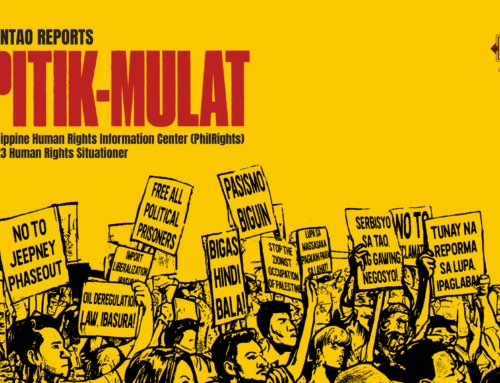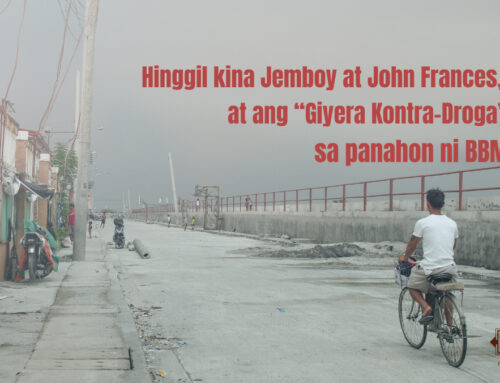Download the full report as PDF (11 mb)
by the Philippine Human Rights Information Center
Monitoring and Documentation of EJKs and Other Human Rights Violations
From the time Rodrigo Roa Duterte assumed office as the 16th president of the Philippines in 2016, there has been a significant increase in human rights abuses in the country. His centerpiece policy, known as the so-called war on drugs, has led to the deaths of thousands of Filipinos and the infringement of rights for thousands more.
Inaction, injustice, and the perpetration of human rights violations continue under the new Marcos Jr. regime. Even as blood-soaked news reports of police operations gone wrong have dwindled in recent years, cases of killings, illegal arrests, arbitrary detention, and enforced disappearances continue to occur in most hotspots.
The flagrant refusal of the now year-old Marcos Jr. administration to engage meaningfully in pursuing justice for those slain and in overhauling a massively corrupt and systemically abusive law enforcement culture that has caused so much suffering is an appalling betrayal of the State’s obligation to uphold the rights of its citizens.
In some ways, inertia has set in. The shock and awe of the campaign’s early years have been replaced by a numbed acceptance of a culture of violence so normalized that they rarely end up splashed on screens and newspaper front pages anymore.
In this report, we present the findings of the Philippine Human Rights Information Center’s (PhilRights) monitoring and documentation activities covering cases of alleged human rights violations committed under the so-called war on drugs from July 2016 to December 2022.
This report, five years in the making, covering six years of cases documented from eight hotspots, is but a snapshot of the extensive harm caused by the so-called war on drugs. Indeed, the pressing duty of recording instances of violations, ensuring they are not forgotten by the public, and collecting evidence that can be utilized for exacting accountability remains more urgent than ever.
Kayâ naman, magpapatuloy tayo.
Our Methodology
PhilRights’ documentation abides by the principles and investigation guidelines set by The Minnesota Protocol on the Investigation of Potentially Unlawful Deaths (2016). This document, also known as The Minnesota Protocol, was issued by the Office of the United Nations High Commission for Human Rights (OHCHR) to set international legal standards to prevent unlawful deaths and investigate extra-legal, summary, and arbitrary executions.
The Minnesota Protocol clarifies that a “potentially unlawful death” may (1) have been due to the acts or omission of the State, its organs or agents including law enforcers, paramilitary groups, militias or death squads allegedly “acting under the direction or with the permission or acquiescence of the State,” and “private military or security forces exercising State functions,” (2) have happened when the victim was in detention by or in custody of the State, its organs or agents, and (3) have been due to the failure of the State to fulfill its obligation in protecting life. Under international law, a “potentially unlawful death” is the product of an arbitrary, summary, or extra-legal execution or an alleged extrajudicial killing. In the event that the victim survived the incident, the violation is referred to as “frustrated or attempted extrajudicial killing.”
PhilRights works with community partners in Manila, Caloocan, Malabon, Navotas, Valenzuela, and Quezon City, and the provinces of Bulacan and Rizal for the referral of cases that occurred from July 2016 until the present, for the monitoring of human rights situation in the communities, and for the provision of assistance to victims and their families. The information obtained from the interviews with victims, families, and witnesses are checked against media reports, police records, death certificates, and other sources of information.
Our Key Findings
Demographics of EJK Victims
- Two hundred and twenty (220) victims of alleged extrajudicial killings were documented. The victims are mostly male adults within the productive age range, are family breadwinners or major contributors in the family’s income, are low- and irregular-wage earners from the informal sectors, are of low educational attainment and are residents of urban poor communities.
- On average, the victim contributed around 59% of the household income. On average, one victim had three dependents.
- The 220 documented victims altogether left behind 324 children. Three children lost both parents.
- Three out of five of the documented victims had links to illegal drugs. Informants cited that the nature of the victims’ work was a contributing factor to drug use (e.g., staying awake for long shifts at work).
- Two out of five had no known links to illegal drugs and were believed to be killed because of schemes such as mistaken identity, palit-ulo (victims who were killed in place of others, possibly to reach a certain quota), or damay (victims killed in operations targeting other persons).
Modalities and Patterns
- The peaks of documented killings were in August 2016, August 2017, July 2018, October 2019, and July 2020. Over half of documented killings occurred between 6 PM and 6 AM.
- Most of the killings were perpetrated in impoverished areas such as the informal settlements of Tondo (Manila), Malabon City, Navotas City, the relocation sites of San Jose del Monte City in Bulacan, Navotas City, and Bocaue in Bulacan. In Caloocan City, the communities of Bagong Silang and Tala also registered high numbers of killings.
- We have categorized three types of incidents according to alleged perpetrators: (1) police operations (including incidents where victims were under police custody); (2) operations believed to be conducted by the police as alleged by informants; and (3) operations conducted by unidentified assailants and riding-in-tandem killers.
- Around five in ten of the documented victims were killed in police operations and under police custody. Around two in ten documented victims were killed in operations believed to be conducted by police as alleged by informants. Around three in ten documented victims were killed in operations conducted by unidentified assailants
- Almost all documented victims bore gunshot wounds; one in six victims allegedly bore signs of torture, including beatings, dismembered body parts, broken limbs, missing fingernails, and burn marks.
- Over half of all documented victims bore three or more gunshot injuries, with two victims sustaining at least 20 gunshot wounds in operations believed to be conducted by police . Five out of seven victims had head and neck bullet wounds.
- One in seven victims had been visited by an Oplan Tokhang team prior to being killed. Three victims had undergone rehabilitation activities.
- Alleged violations occurred before and after the killing for some of the victims. These include torture, unlawful arrest and arbitrary detention, illegal searches and ransacking, harassment and threats, loss or destruction of personal properties, and denial of medical care.
- Alleged tampering of evidence, including the intervention of funeral personnel immediately after the killing as well as the taking of already dead victims to hospitals, were reported by informants in over half and in one-fifth of the documented cases, respectively.
- A review of available certificates of death of documented victims revealed erroneous and insufficient details on the causes of their deaths. Nine were recorded as having died from cardiac arrest or myocardial infarction while three were said to have died from pneumonia and another from acute respiratory distress syndrome. These thirteen (13) victims all bore gunshot wounds.
- About one in six documented victims were alleged by police and media reports as having fought back. About one in seven incidents reported a presence of an average of two handguns while about one in five documented incidents reported an average of three sachets of illegal drugs. Most informants assert that this evidence did not belong to the victims.
- Families of about two in three documented victims found it difficult to gain access to documents, especially police and medico-legal reports.
- Out of 220 cases, only the families of fourteen (14) documented victims reported that they were contacted by police for an investigation.
Other Gross Violations
- Six victims of alleged frustrated extrajudicial killings were documented. The victims and their families were forced to seek sanctuaries or relocate to other provinces.
- Ninety-three (93) alleged victims of illegal arrest and arbitrary detention were documented. A four-year-old girl is the youngest documented victim.
- Nine alleged victims of enforced disappearance were documented. All nine victims have not been found. A female victim was allegedly last seen during a police operation. Another female victim was last seen inside a police station.
- Most of these gross violations occurred in communities where documented extrajudicial killings are also prevalent.







